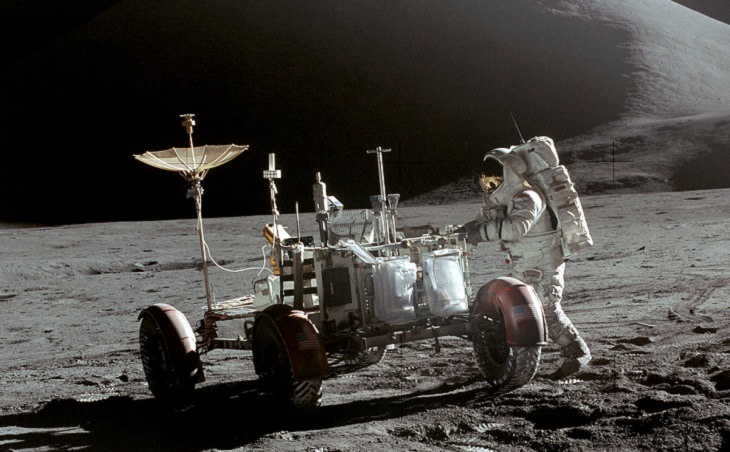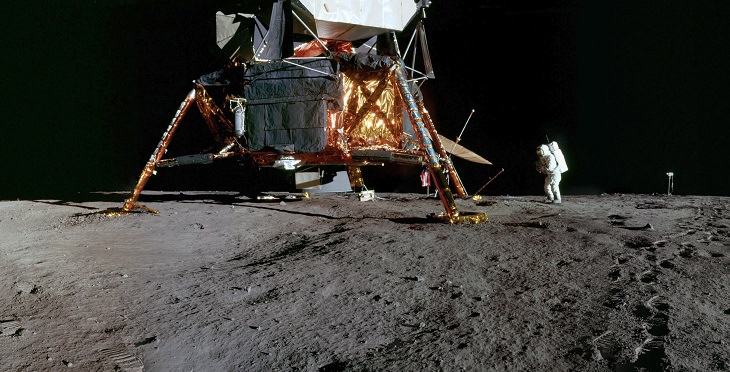

Apollo 17 was the sixth successful manned mission to Moon from NASA, the last recorded landing of humans on the moon. It was launched on 7th December 1972 with crew Eugene Cernan, Harrison Smith, and Ronald Evanan.
However, only Cernan and Smith stepped down onto the surface of the Moon as they had some scientific experiments they needed to carry out. They spent three days there collecting a number of lunar samples.
They covered 36 kilometers of the moon surface using lunar rovers, collecting lunar samples from 22 different locations. They also collected both ancient and younger volcanic rocks, including soil from a depth of three meters. After finishing all their experiments, they safely returned to Earth on the 19th December.
2. Apollo 16, 21st April, 1972
Apollo 16 was the first mission to land in the highlands of the Moon’s surface. The spacecraft was launched on the 16th April, 1972, from the Kennedy space center and made a safe landing on the Moon five days later.
American astronauts John Young and Charles Duke spent three days on the lunar surface. They used lunar rovers to help them carry out nine scientific experiments at eleven different sites. They also helped them to collect almost 90kg of samples from the Moon.
Their colleague, Ken Mattingly, spent four days on lunar orbit during this mission and captured many images of the Moon from orbit. They returned to Earth on the 24th December, 1972.

This was the first manned mission to use a lunar roving vehicle. It was launched on the 26th July, 1971, with David R. Scott, Alfred M. Worden, and James B. Irwin. They landed safely on the Moon on the 30th July, 1971, in the Hadley-Apennine region where the Mare Imbrium (a vast lava plain) is located.
Scott and Irwin performed 18.5 hours of extra-vehicular activity on the lunar surface using the rover. The collected 370 rocks and soil samples. On the other hand, Worden made a number of scientific experiments from lunar orbit.
They spent 2 days and 19 hours on the Moon and returned to Earth on the 7th August.
4. Apollo 14, 5th February, 1971
Apollo 14 was launched on the 31st January, 1971, from the Kennedy Space Center. Alan Shepar Jr., Stuart A. Roosa, and Edgar D. Mitchell, were the three American astronauts on this mission. They landed on the surface of the Moon on the 5th February, 1971, in the Fra Mauro valley. Their primary mission was to collect as many samples as possible from this area.
Mitchell and Shepard Jr. collected many rock and soil samples, while Roose remained in lunar orbit and carried out a number of scientific experiments. They spent 33 hours on the Moon and returned to earth on the 9th February.

This was the second most successful manned Moon landing by NASA. It was launched on the 14th November, 1969, with Charles P. Conrad, Alan L. Bean, and Richard F. Gordon as the crew. They landed safely on the Moon’s surface on 19th November, 1969, in the Oceanus Procellarum area.
Conrad and Bean spent almost one day and seven hours on the Moon collecting lunar samples, carrying out experiments and taking photographs of the surface. They collected 35 kilograms of lunar samples and returned to Earth on 24th November, 1969.
6. Apollo 11, 20th July, 1969
This was the first ever spacecraft to put a man on the Moon. It was launched on the 16th July, 1969, from the Kennedy Space Center with Neil A. Armstrong, Michael Collings, and Edwin E. 'Buzz' Aldrin as the crew.
Armstrong became the first human to step on the Moon at 10.56 pm EDT on the 20th July, 1969. Aldrin also joined Armstrong to explore the lunar surface. They spent 2 hours and 50 minutes on the surface of the Moon, collecting samples and carrying out a number of experiments. They also took many photographs.
They completed all operations and experiments satisfactorily and returned to Earth on 24th July, 1969.
Source: themysteriousworld
Related Articles:
Celestia User Guide: a Free 3D Space Exploration Program